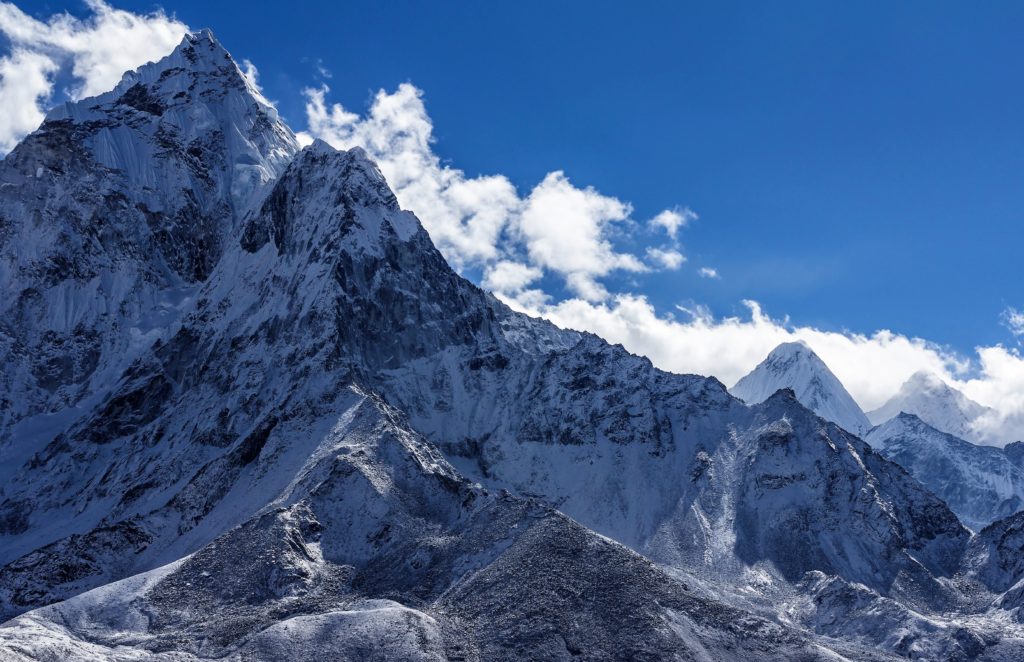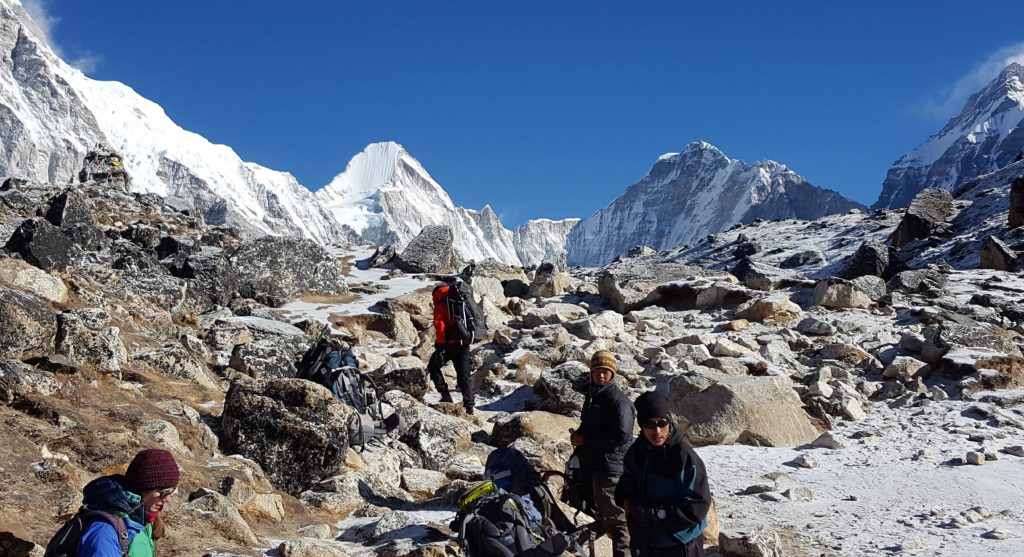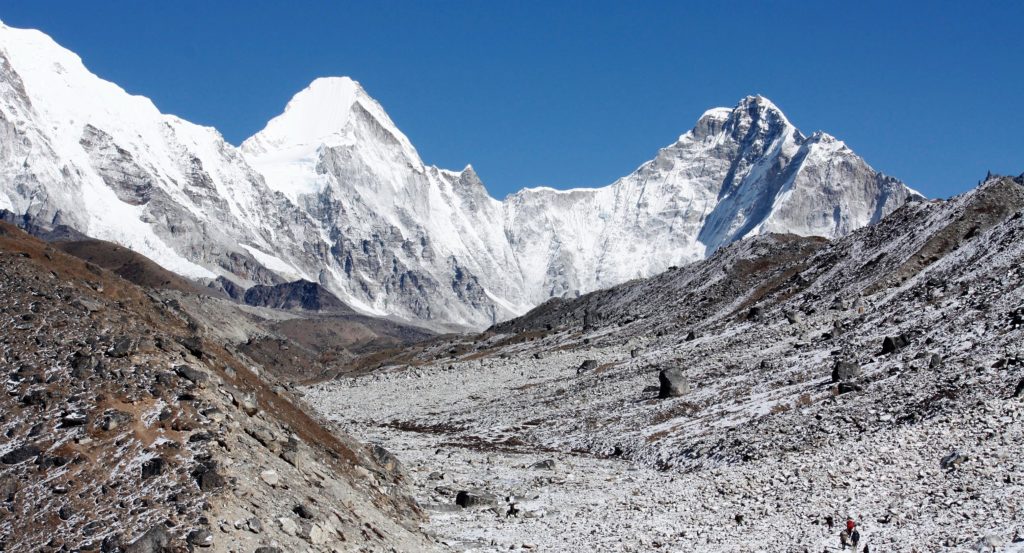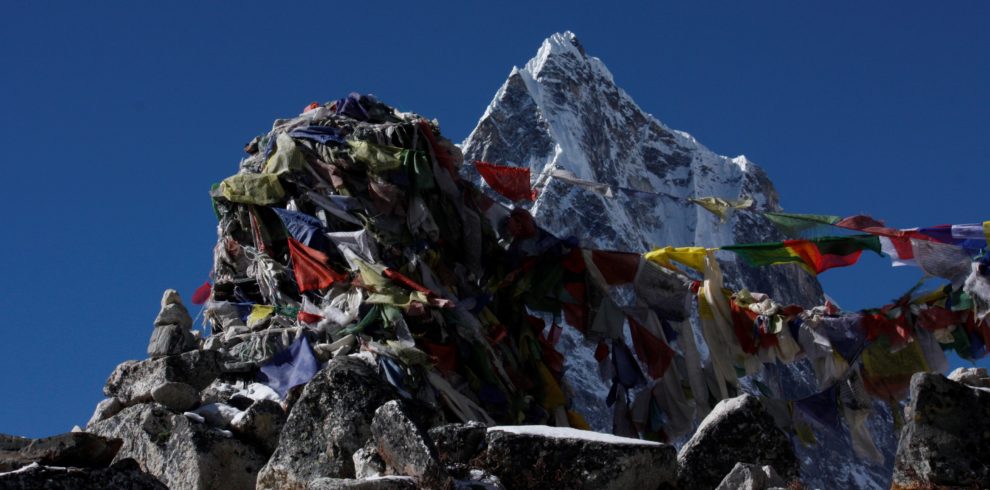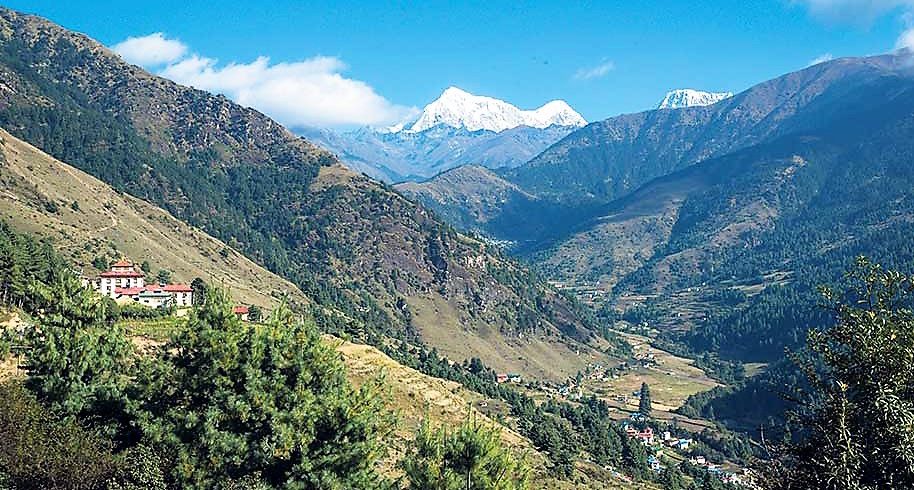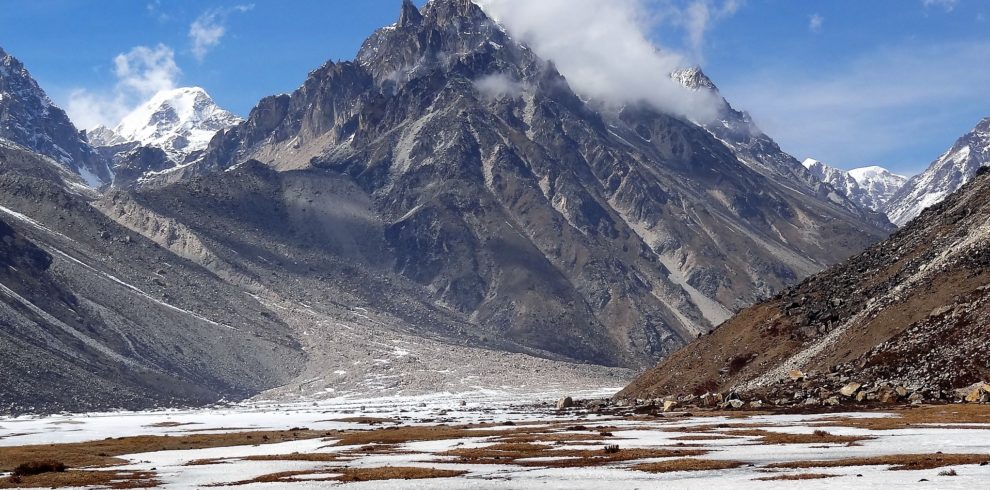Budget Everest Base camp Trek offers shot days encounters of Everest Valley. To been Everest Base Camp is a dream of many adventure seekers since it is a base of the highest peak. So we are endeavoring this Short Everest trek in the cheap budget for everyone. This Budget trek itinerary almost the same as popular 14 days Everest Base camp trek. So, It is for those customers who are looking for adventure on their tight budget. More, the itinerary target for the western busy lifestyle. Those who cant afford such a long day trip to the Himalayas.
However, we have created this budget itinerary for those who can do long day walk and tolerance high altitude. Remember that we have designed this short Everest base camp itinerary to prevent high altitude sickness. We know that your goal is achieved such a beautiful panorama from Kalapather. In fact, Believe us, Everest hiker team would love to make your dream into reality.
The major attractions of the trek are Kala Patthar (5,545m), the towering peaks (Mt. Everest, Mt. Lhotse and Mt. Cho Oyu). Namche Bazaar, Phakding, Tengboche and Dingboche are some main attractions of this Budget Everest Base camp trek. Everest hiker does operate various short Everest trek packages.
How does Budgets Everest trek work?
Since the first day, we will pick up you from your Kathmandu hotel a day before the trek. According to the programs, the team introduces your guide as well as provides you the information about Short Everest trek. Next, early morning your guide will come to pick up you for your adventure. By the time we land at Lukla, the trek begins towards the journey about 2-3 hours Phakding. Whereas we gonna stay overnight at Phakding. After having breakfast, after approaching Sherpa kingdom Namche Bazaar.
This Everest trekking is sure to be an event of a lifetime. Whereas in this Budget Everest base camp package included accommodation, guide and porter service. Everest hiker team’s primary goal is to take you to the Base Camp reliably. Finally, we will experience the base as well as Kalapather’s view and came back safely. Moreover, we Have to quick down Lukla within 3 days after reaching Ebc.
The budget for food cost to Everest base camp is relevantly expensive so the cost varies on choice. The Trek cost range of Budget Everest base camp is about 1000 USD up to your choice. Finally, the experience of Everest trek continues to descend Namche Bazaar to Lukla and fly out to Kathmandu.
Overview
Sherpa Culture and tradition hub
Many High suspension Hanging Bridges during the trek
Tibetan Buddhism and practice
1 Night rest and acclimatization days before conquer Everest Base Camp
Closure view of Himalaya route to Everest Base Camp trek
The highest Base camp of highest Mountain Khambu (roof of the world)
Breathtaking view of Mount Everest Sunrise or Sunset from Kala Patthar
Comfortable Accommodation and hygiene meals every day served
Acute Mountain Sickness friendly itinerary
Scenic Mountain flights from Lukla to Kathmandu
Trekking in the famed Everest Valley
Closure view of Himalayas in route to Everest Base Camp
Explore Namche Bazaar, the capital of the Sherpa people
Explore Khumjung Village and the museum, Hilary School
Magnificent view Everest Base Camp, Khumbu Glacier, and Kalapatthar
Watching the world’s highest Mt Everest with Mt Ama Dablam and more
After landing at the Tribhuwan International Airport. You will greet by a representative of Everest hikers who will drop us off at our hotel according to your recommendation. Later we introduce with your guide.
We take an early morning adventures flight to Lukla your Everest treks begin now. We meet the rest of our team in Lukla after breakfast we start our trek. We walk on a trail that gradually descends to Cheplung village from where we get a glimpse of Mt. Khumbila, a sacred mountain which has never been allowed to climb. From here, we gradually descend until Phakding village. Overnight in Phakding. Included meals: Breakfast Lunch Dinner in the Same lodge.
Our trail leads through a pine forest and we continue our walk on the trail that goes north up the Benkar valley and for sale. We cross Dudh Koshi River and pass Chumoa and Monjo villages before reaching the entrance of the Everest National Park. All these villages are on the edge of the river, Then after crossing a suspension bridge, we pass Jorsale village and walk alongside the Dudh Koshi and Bhote Koshi rivers. We ascend steep trail around 2 hours continue to reach Namche Bazaar which is the gateway of the Everest region. Overnight in Namche Bazaar. Included meals: Breakfast and Dinner in the Same lodge.
We will spend 2 night in this village for acclimation. Do tour Namche Bazaar which is the primary town of the Everest or Khumbu region and has government offices has lots of ATMs, internet cafes, shops, restaurants, and a colorful market. We can hike-up to Sagarmatha National Park and enjoy the sunrise over the Himalayas including Mt. Everest, Lhotse, Nuptse, Ama Dablam, Thamserku, Kongde and more...If we are interested in a day hike, we can trek to Khumjung village where the Hillary school and some museum belongs. Overnight in Namche Bazaar. Included meals: Breakfast Lunch Dinner in the Same lodge.
The trek until Phunki is an easy walk beside 10 min climb from the Namche hotel. From here we ascend towards Tengboche village which houses the very famous Tengboche monastery which is the biggest monastery of the Everest region lies and our tour organizer used to spend his life here. The monastery is blessed to linked Tibetan monastery and with panoramic views of the Himalayas, including Mt. Everest, Nuptse, Lhotse, Ama Dablam, and Thamserku. Overnight in Tengboche.
Included meals: Breakfast Lunch Dinner in the Same lodge.
Our trail descends and passes through lush forests of birch, confer and rhododendron trees until crossing imja valley and Khambu Rivers. While trekking we can admire good views of Mt. Everest, Lhotse, and Ama Dablam. We walk downhill to Debuche and cross the Imja River to reach Pangboche. We choose the upper Pangboche trail and admire the Himalayan vista and the Pangboche Monastery which is in front of AmaDablam. Overnight at Dingboche Included meals: Breakfast Lunch Dinner in the Same lodge.
We ascend to the steep terminal moraine of the Khumbu Glacier. The top of the ridge is filled with prayer flags and stones which are memorial shrines for climbers who lost their lives on Mt. Everest. And around. We find ourselves facing several great peaks including Khumbutse, Lingtren, Pumori and Mahalangur Himal. As we are crossing Khumbu Glacier we can also see Mt. Nuptse. Overnight in Lobuche. It will be cold night comparing other night due to Lobuche lies in the top of the hill. Overnight at Lobuche
Included meals: Breakfast and Dinner same lodge
The trek to Everest Base Camp is not very difficult if your body acclimatizes easily. However, we ascend and descend mostly on a glacier path until reach last Gorakshep. There is also a lot of meandering on rough terrains on the way. After lunch, we reach the base camp, we enjoy the incredible base of Everest and admire the gently rounded ice towers on the upper part of the Khumbu glacier. The Everest Base Camp is stunningly beautiful in full shape. We can enjoy fantastic views of Nuptse, Khumbuste and Pumori mountains from the base camp but no Everest. After exploring in the beauty, we walk back towards Gorak Shep where we spend the night. Overnight in Gorak Shep. Included meals: Breakfast Lunch Dinner in the same lodge.
We wake up early for the catch up to Kala Patthar sunrise view. It takes us 2 and a half hours. Early morning dark outside with cold temperature and most likely chilly winds. We walk on a fairly steep trail at a comfortable pace because we will get very soon tired. As we are climbing up the hill we can see Lingtren, Khumbutse, and Changtse mountains another side. The view from the summit is outstanding panoramic. After spending some time at the summit of Kala Patthar, we walk back to Gorak Shep and breakfast same day down. After lunch, we descend to Pheriche to spend the night.
Overnight in Pheriche. Included meals: Breakfast Lunch and Dinner
We wake up early for the catch up to Kala Patthar sunrise view. It takes us 2 and a half hours. Early morning dark outside with cold temperature and most likely chilly winds. We walk on a fairly steep trail at a comfortable pace because we will get very soon tired. As we are climbing up the hill we can see Lingtren, Khumbutse, and Changtse mountains another side. The view from the summit is outstanding panoramic. After spending some time at the summit of Kala Patthar, we walk back to Gorak Shep and breakfast same day down. After lunch, we descend to Pheriche to spend the night.
Overnight in Pheriche. Included meals: Breakfast Lunch and Dinner
We quickly lose elevation today and walk on a trail with a lot of ups and downs. We start to feel so warm and so comfortable ourselves. We descend rapidly through the pine forest where we can easily spot mountains goats, pheasants, and other wild animals and birds common to the area in front of mighty mountains.
Included meals: Breakfast and Dinner
We begin our trek to Namche Bazaar today on rocky terrain, it seems natural for us to descend toward the hill. It is mostly a downhill trek on a trail alongside the Dudh Koshi River. We cross several suspension bridges, pass by several monasteries and villages before reaching Lukla. After reaching Lukla we spend the rest of the day taking rest as today will be our last day on the mountains. Overnight in Lukla. We will say goodbye to porter and Khumbu tonight. Overnight at Luka, Included meals: Breakfast and Dinner
We will catch an early morning flight to Kathmandu after our long mountain journey. After reaching Kathmandu, the day is yours do some souvenir shopping. If we want to explore any other areas of Kathmandu, we may do that today. Our guides can help you with both souvenir shopping or sightseeing around the city. There will be a farewell dinner in cultural programs. Overnight in Kathmandu.
Included meals: Breakfast Dinner
What's included in the cost?
- Airport / Hotel / Airport pick up & drop by private tourist vehicle.
- Two nights standard twin sharing accommodation in a three-star level hotel in Kathmandu; Breakfast included. (2 nights)
- All your standard Meals during the trek (Breakfasts, Lunches, and Dinners)
- Lodges, Guesthouses accommodation during the trek
- Licensed English speaking guide.
- The required number of local staff and porters to carry your luggage during the trek (We assign one porter for every two guests).
- Food, accommodation, salary, insurance, equipment, and medicine for all staff.
- Everest National Park permits and TIMS permit for trekking.
- Airfare from Kathmandu – Lukla – Kathmandu including airport departure tax in Kathmandu and Lukla airport.
- Surface transfer from and to Kathmandu.
- Farewell dinner in a typical Nepali Restaurant with on the second last day.
- All our government taxes, vat, tourist service charges.
- Official expenses.
Cost doesn't Include
- Air travel to/from Nepal,
- Lunch & dinner in Kathmandu,
- Soft/hard drinks, laundry, postage, telephone bills, all items of personal nature,
- Personal clothing, insurance against accidental, medical and emergency rescue evacuations,
- Respective expenses if one returns earlier from the trip due to sickness or emergency purpose.
- Sightseeing around Kathmandu valley.
- Travel Insurance
- Emergency helicopter rescue evacuation arrangements will be cover by travel insurance.
Check Gear list for Everest hiker
In most of the causes before start our adventure, we’ll spend a day or part of a day doing some casual sightseeing in world heritage site valley surrounding before we leave for the trek, and we’ll check gear when you arrive if anyone needs for the trek. Please have photos, passport photocopy airline tickets to re-confirm and insurance information ready if needed. Let’s us detail.
Recommend Day-pack for Everest hiker
We recommend a 30-45 liter Day-pack for each in case of porter hiring. Better to have it too large than too small, as on pass days you’ll want to carry more when you need. Most have internal water bladders built in, which are good to have it for any situation. Make sure it’s comfortable before leaving home. Mines are 55 and 65 liters.
Generally if you are going to hire porter in your daypack, you’ll be carrying 1 or 2 liters of water, a wind/Gortex/soft/ hard-shell jacket, wind/rain pants, hat & gloves, extra socks, sunscreen, snacks, water purifying tablets or filter, camera, a plastic bag or pack-cover and maybe a down jacket. Others remaining porter will assist you.
Packing/Storage
It’s easiest to pack and unpack from a duffel-bag, do for the most natural, porters to carry as well… Inexpensive and/or sound quality duffel are available in Kathmandu, but we can provide upon your request but it’s best to invest in a robust and waterproof duffel such as a North Face. You can leave/store extra gear in Kathmandu at our office storage room free of charge.
Extra Gear & Villagers
If anyone has old/extra/used gear of any sort, bring it along if you have room in your duffel you can donate it for porters and some orphans center or donation for villagers.
Our porters & staff also appreciate it can be old shirts, jackets, pants, fleeces, shoes to your old trekking socks. We often have a raffle on the first day of the trek, and each porter will get at least one ‘new’ thing, which is fun for them.
Recommend Snacks for Everest hiker
It’s always good to have some snicker or bars at lower elevations. You crave terrific things at altitude, and often need energy in a way that you usually don’t at lower altitudes energy bars, electrolytes, etc are essential for long days or passes. Lemonade mix, Emergen-C, Tang, etc great to have for hot days in your water bottles it can make huge differ. If anyone has a favorite cookie/biscuit, bring a package to share in the tent in the evenings with staff if you want. And anything else that you can bring particularly likes.
Water Purifiers & Filters
You can bring an MSR ceramic purifying/filtering pump along on the trek which everyone can use to pump fresh water in the evenings for the next day’s drinking water, ecologically the best way to get water in the Himalaya’s fragile trekking regions. Bring your pump, UV purifier or iodine tablets to have the capacity for fresh water whenever you want in route. Please bring at least unbreakable plastic/metal water bottles.
What we need for Everest trek
A copy of your travel medical insurance (just one sheet with policy number, name, and international contact numbers) as well as password photocopy.
A copy of your Passport (front page) and Nepal visa
3 Visa-sized photo
Cash for Everest trek
We run trek basis on cash during the trek for drinks, snacks, candy bars, biscuits, beer, etc. There’s some good shopping in Namche, sometimes a chance to buy locally made products. For tipping the crew we recommend about $100 per person in Nepali rupees or USD. There are ATMs in KTM which give you 350 USD, and many money changers, banks, etc available in Kathmandu and Lukla. In Namchhe, you can change TCs or cash, and some other places cash but we recommend you do it in Kathmandu. Guide also have extra rupees with them if anyone runs out and needs to borrow. For each Everest hiker, $250 is an excellent amount to change when you arrive in KTM.
Camera/ mobile Batteries recharge system
There are now many places to recharge batteries in the Everest, Annapurna, Manaslu and Langtang region so bring your camera battery chargers otherwise bring your solar panel. We recommend always bringing extra batteries as it takes time to charge and there is often a line in busy time, charging is not always available and it can get expensive to charge your batteries up higher!
Washing & Showers in Everest trek
Showers are almost always available at the lodges of Everest regions. But they’re not cheap generally per head 3-5USD up to. So budget some extra cash if you like to shower daily! You can have (at no cost) a ‘warm washing bowl’ to wash up with. As for clothes, bring a small package of soap powder, and you can either wash your clothes yourself or laundry available in Namache our porters some money to wash them for you! That sometimes works.
Sleeping bag for Ebc trek
Down-filled sleeping bags rated to -10º are best because high altitude nights will be fresh for hikers but for peak climber more than…Good down is fluffy, light and thick. A muff makes a big difference to the overall warmth of a bag and a mummy bag is generally warmer than a rectangular one. If your bag is rated for a higher temperature add a fleece sleeping bag liner to add warmth to the alpine zone.
Day-pack for everest base camp trek
This should be comfortable in your choice, with a right waistband that transfers some of the weight to the hips. It needs to be big enough to take a jacket, fleece, drinking water, camera and odds and ends you might like during the day which should be always with you.
Duffel Bag for Everest hiker
If you travel with porters, bring your gear in a duffel bag which help to excess easy. Several companies make good duffel bags with a zipper along the side for ease of entry choose the best one. Get a bag that is durable and has a sturdy zipper some time it makes different. A duffel bag 40cm in diameter and about 80cm long is large enough to carry your gear and will usually meet the weight limit of porters and domestic flights rules.
Recommend Trekking Boots, for Everest trek
To finish happily trek you need comfortable feet. Quality boots have good ankle support, plenty of toe room for long descents, a stiff sole to lessen twisting torsion and are light, due to you don’t tire. Look at the inner lining – leather is good and Cambrelle is even better, a material that eats smelly foot bacteria and makes the extra relief. Good lightweight trekking boots or light all leather boots are ideal for a long day trek. Avoid arriving with brand new boots that you have not yet used before! Walk in your new hiking boots on some steep hills and make it smooth that will test trouble spots before you leave home. The longer the trek, the better the boots you need, so took the best one for a happy journey.
Socks,
In the low country area, your feet will be warm or even hot while walking so quality cotton mix sports socks are excellent. Three to four pairs are enough for the trek. Thick trekking socks are better for higher up because you may walk in the snow, and evenings are cold where you can exchange. We suggest you bring four pairs or even 1 more. Most modern trekking boots fit snugly so wearing two pairs of socks at the same time is impractical to think twice.
Camp Shoes,
Luxury for your feet at the end of the day: sandals or running shoes is the best idea.
Fleece top,
Most trekkers consider this is essential, but alternatives are a thick thermal top or a light down jacket. In Kathmandu, you can get cheap Korean fleeces but they are not the best quality you needed.
Down Jacket or fiber-filled jacket,
Down clothing has the advantage of being light and compressible for alpine. A down jacket will stuff into a small space when packed, yet puff up. You should bring a good down jacket on all treks from your country or can buy in Kathmandu. Most ski jackets that have been used in your country are not warm enough and most so-called expedition parkas are too heavy and bulky. Don’t bring both a heavy and a light down Jacket; choose one that will serve both purposes, preferably ideal one with a hood that is also stuffed with down. If you feel extremely cold at high altitude, you will likely to wear your down jacket inside your sleeping bag.
Wind or rain jacket
During the day trekking, you can use windproof, Waterproof and breathable. Plastic ponchos or non-breathable raincoats are not suitable for the trek.
Fleece/sweatpants,
Great for the chilly evenings, thicker is better and polypro is better than cotton in high.
Day-wear shirt,
T-shirts are favorite but a shirt with a collar and long sleeves are more practical during the day or in the evening. Regularly you can use two so you can swap damp for dry. Look one for shirts made of quick dry fabrics rather than cotton.
Trekking pants,
You will live in these. Light material, loose fitting, and dark-colored are best.
You can survive with only one pair but you have to bring two; get dusty or muddy so a change is a good idea. Cotton cheapies some marks in the local fashion, it is not necessary to have gore-tex or waterproof pants.
Neck gaiter,
For winter trekking they are the best for staying warm you need it, A fleece triangle with a Velcro fastening works well and is easy to pull up when the yaks stir up trail dust.
Trekking poles,
Useful, especially on steep, rough terrain, but if you are not used to using them you will not miss them someone who loves to do photography thinks twice.
Sunglasses,
Highly recommend good one suitable for snow, as it is bright up there, but specialized glacier glasses. Contact lens wearers report very few problems except cleaning them in the conditions it’s your matter. Ski goggles are unnecessary for trekking.
Mittens/Gloves,
These don’t need to be fancy (pockets are the warmest solution to cold hands), so local Kathmandu fleece gloves are excellent but you need it.
Water bottle,
Should be a one-liter size, except boiling water, and be leak-proof. You have to bring 2 or liter capacity in all. Sometimes mini Thomas a metal bottle can double as a hot water bottle on cold nights.
Torch,
LED bulbs are best for mountains. You will need a lamp for reading after dark, and for finding your way to the outhouses. A headlamp is excellent for climbing although many people prefer the second torch it’s enough.
Toiletries and odds and ends,
Bring essentials for the trek only otherwise you can buy in tea houses. There are a surprising number of showers or buckets of hot water available in the hotel. The smallest tube of toothpaste is perfect for a month in your favor. Roll-on deodorant can spare you grief with your tent partner toilet paper need. Hand cleaner in a bottle (“Purelle” or similar) is a good idea, it would be better for the environment than “handy wipes”.
Towel,
Bring only a small one for trekking, or consider using a sarong. Mountain shops sell towels made of a quick dry fabric which is cost around 10USD. In Kathmandu, city hotel do supplies towels. Sunscreen and lip care with sun protection extremely needed during the day sun is intense at altitude, especially after snow, and you will want to use these most days.
Water purification,
One bottle of iodine tablets between two, Douglas or Potable Aqua is the best one. Shops in Canada sell Pristine, which is a good option. We tend to use boiled water from the lodges but occasionally we need to take water from the streams. The use of mineral water bottle is discouraged from an environmental point of view and the higher it cost more.
Snow gaiters
These are not needed, but bring them if you already have some in case we get or cross a pass about 5400M high or you are coming in the winter season.
Evening camp wear,
Around the evening camp, you can wear camp shoes, lights sandals or leather boots. No matter what altitude and what season the temperature can get to -10º after dark. By far the best clothing is:
+ A down jacket, medium weight
+ Thick fleece pants
+ Fleece hat and neck gaiter
+ Thick shoes with wool socks
Available in Kathmandu or bring from home that we need.
1) Sleeping sheet
2) Duffel Bag
3) Trekking pants
4) Wind pants
5) Fleece top
6) Warm hat
7) Light gloves
8) Toilet paper
9) One litter of water bottle
10) Pee bottle
11) Lip care
12) Torch
13) Snow Gaiters
14) Water purification
Bring from home
1) Sleeping bag
2) Daypack
3) Trekking Boots
4) Running shoes
5) Socks
6) Camp shoes
7) Rain jacket
8) Nightwear top
9) Neck gaiter
10) Daywear shirt x2 or 3
11) Underwear
12) Sun hat
13) Sunscreen
14) Sunglasses
15) Toiletries and odds and ends
16) Small towel/sarong
17) Personal medicines
18) Camera
19) Money pouch/belt
20) Passport photos 2x
21) USD40 cash for a visa (30 days visa)
Budget Everest Base camp trek
DISTANCE FROM LUKLA TO EVEREST BASE CAMP: It is 38.58 miles or 62 Kilometers within 8 to 9 days walk. We could explore Ebc trek a 3 to 4 hours day hike. We trek everyday slower due to the extra days needed to allow a person’s body to adjust with high altitudes. If it is not then we get the sickness.
If you set up mind once in a lifetime for Everest Base Came trek than it will be healthy and natural. Exploring Everest base camp is not dangerous now. Usually, the high altitude sickness cause is dangerous. But the availability of Helicopter and the possible rescue from everywhere sounds positive. We have to prepare very carefully properly acclimatize before heading up camp is best.
Everest Base Camp trek cost and itinerary could be different. Ebc trek package range per person from USD$1,200 all the way to $5,000. Also, it depends on the group of people for an average 12 – 15-day trek. Prices generally include All permits, both way flights trip from Kathmandu to Lukla, accommodation, thee meals, Trekking crew. Prices won’t include Personal travel insurance, visa fees, trekking equipment, Int. fly ticket.
Everest trek cost can be different if Everest base camp trek itinerary is short. There is lots of Budget trek and Luxury Everest Helicopter trek package are available online.
Everest view from Everest base camp. No, we can’t see Mt. Everest from base camp, you can mostly see Mt.Pumari Nuptse and the Khumbu Ice Falls. The summit of Everest is hidden behind the South Col. The best view of the Mt Everest summit, Khambu Glaciers, and Everest base camp is from Kala Patthar.
We can see the best view from Gokyo Ri: including Mt. Everest, Mt. Makalu Mt.Pumari and Nuptse.
It is almost impossible to climb Mt. Everest utterly alone on the standard route. Even it is impossible to climb most of Nepali Mountains. However, the excellent climber can climb independent with no oxygen, Sherpa or cook support. But using ladders and ropes on the south side is necessary. For one person this would cost minimum $20,000 – max USD 50000 from Nepal. It would be a bit less from China.
Every season weather could be different in Everest Himalayan Region. However, the Everest Base Camp and Kalapathar by Helicopter flight can be explored thought-out year. Usually, the weather stays clear, April, May, Sep-August- Oct Nov- Dec- January-Feb. During the morning time all time of the year and even in the Monsoon period we can see the panoramic view. In case of bad weather, the helicopter does not fly it means you will get refund money.
Best months for the trek to Everest Base Camp in March, April, May, September, October, and November. Ebc Helicopter flight tour to Everest can be down all time of year.
The budget for food cost Everest base camp trek is relevantly expensive. Cost range of Budget Everest base camp trek is about 1000USD up to your choice.



